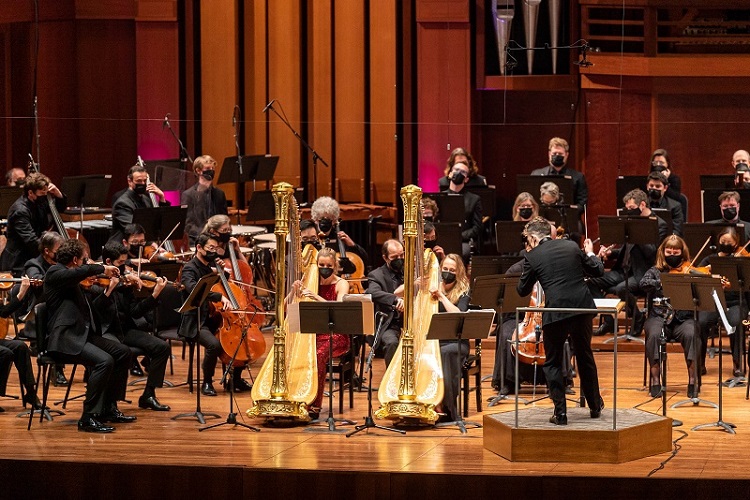 United States Lash, Beach: Hannah Lash and Valerie Muzzolini (harps), Seattle Symphony Orchestra / Lee Mills (conductor). Benaroya Hall, Seattle, 18.11.2021. (ZC)
United States Lash, Beach: Hannah Lash and Valerie Muzzolini (harps), Seattle Symphony Orchestra / Lee Mills (conductor). Benaroya Hall, Seattle, 18.11.2021. (ZC)

Hannah Lash – The Peril of Dreams
Amy Beach – Symphony in E minor, Op.32 ‘Gaelic’
The Seattle Symphony’s most recent concert plan hit a bump in the road. Due to illness, music director Thomas Dausgaard could not conduct a much-anticipated all-female, all-American program. Instead, associate conductor Lee Mills stepped up to the podium. Since joining the Seattle Symphony in 2019, Mills has led the orchestra in dress rehearsals and subscription concerts, and he regularly conducts special performances like this year’s upcoming Messiah concerts.
On the program were works by two composers unfamiliar to orchestra and audience alike, presenting Mills with a challenge to not only guide the orchestra through the works – Amy Beach’s ‘Gaelic’ Symphony and Hannah Lash’s newly commissioned The Peril of Dreams – but to also guide the audience with finesse.
The world premiere of Hannah Lash’s The Peril of Dreams – a concerto for two harps and orchestra – was originally scheduled for 2020, but the COVID-19 pandemic pushed it to 2021. Lash joined Valerie Muzzolini, the Seattle Symphony’s principal harpist, to play the solo parts.
In Lash’s write-up on the piece, she describes the work as a symphony through the lens of a double harp concerto, which is an apt description. The two harps stand apart from the orchestra, but they avoid drawing all the attention. At times they strike out with beautiful solo moments that captivate with their fragile beauty, which might be expected in a typical concerto, but these moments are never enough to give the soloists an identity separate from the rest of the orchestra. Lash’s writing for orchestra is also tantalizing. She clearly knows how to draw the most from an orchestra’s array of colors and effects, yet too often her most enchanting orchestral moments are mere fragments: they pique interest but are never able to hold the listener. Perhaps this is the peril of dreams that she alludes to in the work’s title
After the intermission, Mills and the orchestra returned with Amy Beach’s well-crafted ‘Gaelic’ Symphony in E minor. Composed in 1894 and premiered two years later, Beach’s work sits firmly in the Romantic style, closer to Dvořák than Brahms. But unlike Dvořák, who drew from themes inspired by Native American and African American music for his Ninth Symphony, Beach infuses her symphony with song-like allusions to the British Isles. The work has been a favorite of mine ever since I heard Naxos’ recording with the Nashville Symphony. It has everything I prefer in a symphony – strong melodies, characterful orchestration, momentum and well-proportioned movements. It is the type of piece most professional orchestras can just wind up and go. The Seattle Symphony met the moment with a high-spirited performance that featured Noah Geller’s sumptuous violin solo in the third movement. Mills kept the music moving – precisely what this piece needs.
Mills did well on short notice. He knows the orchestra and they know him. Dausgaard might have been a better advocate, particularly for Lash’s new work, given his ability to whip up an overheated performance. But, in these uncertain times, the hard work of a last-minute substitute made for a pleasant and enlightening experience.
Zach Carstensen
